"Cooking with
Beer!"
March 05, 2009
- Vol 1, Issue 2
| |
|
Updated
Website
|
If you haven't visited our website lately, take a
look. We are updating and expanding our site
daily. I think you will enjoy the changes.
|
E-Newsletter
Drawing
|
If you receive our newsletter, you will be
entered into a drawing each month for a great prize for
your kitchen. Check here each month to see if you
have won, if so, come in to collect your
prize!
Feb's winner: Amber
White
Amber won a personalized Coozie......Congrats
Amber! | |
|
Beer,
the New Wine
|
"I am a firm
believer in the people. If given the truth, they can be
depended upon to meet any national crisis. The great
point is to bring them the real facts and beer." -
Abraham Lincoln
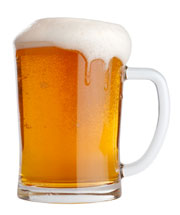 The magic of cooking with wine has
long been known and institutionalized in our cooking
habits. Beer, however, has not received the same
respect in the culinary world until recently. Along with
the rise of domestic micro-breweries and the greater
accessibility of imported beers, respect for "real"
versions of the brew in the epicurean world has grown
far beyond the lowly stereotypes. Beer is
"recession-resistant," an affordable luxury worth
remembering in these times! For less than the cost
of a latte, a great beer can be enjoyed. In this
issue we'll investigate how flavor is created in beer,
discuss how to incorporate beer in your cooking, and
present three recipes to get you started. We'll
even give you some ideas on what to do with any leftover
beer - hmmm, perhaps drink it? The magic of cooking with wine has
long been known and institutionalized in our cooking
habits. Beer, however, has not received the same
respect in the culinary world until recently. Along with
the rise of domestic micro-breweries and the greater
accessibility of imported beers, respect for "real"
versions of the brew in the epicurean world has grown
far beyond the lowly stereotypes. Beer is
"recession-resistant," an affordable luxury worth
remembering in these times! For less than the cost
of a latte, a great beer can be enjoyed. In this
issue we'll investigate how flavor is created in beer,
discuss how to incorporate beer in your cooking, and
present three recipes to get you started. We'll
even give you some ideas on what to do with any leftover
beer - hmmm, perhaps drink it?
"Beer, if drank with
moderation, softens the temper, cheers the spirit, and
promotes good health." - Thomas
Jefferson
|
March
Wine of the Month
|
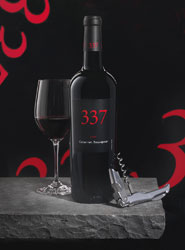 This month we're
featuring: 2006
337 Cabernet Sauvignon 337 Wine
Vineyards Lodi, California Regular
Price: $17.00March
Price:
$11.00
WOW! A spectacular
Cabernet at an incredible price!
If you'd
like to read more about it, check these tasting
notes.
Exciting
new product for your Wine Cellar or Bar
--
Hand-painted Wine Cellar Signs made out of
wine barrel staves. Available in 5 different
sayings. $49.95
|
March Special
Promotion
|
Warm waffles with nooks and the perfect nooks and
crannies filled with your favorite fruit and syrup,
Mmmmm . . . . If all you've known lately are
frozen, toasted imposters, you deserve a chance at the
real thing!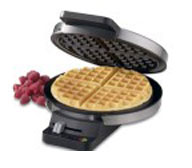
During March, we're
featuring all of our waffle irons! Choose
from
Cuisinart, or Krups,
or Villaware.
These three brands represent the three basic categories
of waffle irons: Flip, Belgium, and Classic Buy
any waffle iron and receive a free mini Stonewall
syrup.
| | |
|
Don't Miss this Upcoming
Event!
|

We're clearing out old
merchandise and making room for spring and summer!
Join us
every Saturday in March for incredible savings on your
favorite kitchenware brands:
Saturday March
7th: Featuring: Wusthof
Knives
Saturday March
14th: Featuring: All-Clad and LeCreuset
Cookware
Bonus:
Free Beer Tasting
Saturday March
21st: Featuring: Seasonal
Items Saturday March
28th: Featuring: Certified International
Retiring Tabletop patterns
Bonus:
Free Wine Tasting
New merchandise and additional
savings will be added each
Saturday! |
What is
Beer?
|
"The mouth of a perfectly happy man
is filled with beer." - Ancient Egyptian
Proverb
Curiously, a great percentage of loyal
beer drinkers don't really know what beer is and how it's
made. Ask a few that you know and you'll hear some
sputtering about malt and hops, but not a firm understanding -
perhaps because it's complex, more complex than wine-making
some would assert. Understanding a little bit about how
beer is made and how its flavors are layered and coaxed will
assist our understanding as we ply its magic in our
recipes.
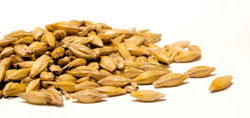 Beer is a fermented beverage made from
grain with many nuanced steps in its brewing. It is made
primarily from barley, yeast, hops and water. From this
short list of ingredients, the wizardry of the brewmaster is
applied. In his book, The
Brewmaster's Table, (an IACP Cookbook Award Winner),
the author and brewmaster, Garrett Oliver expertly describes
the process of making beer: Beer is a fermented beverage made from
grain with many nuanced steps in its brewing. It is made
primarily from barley, yeast, hops and water. From this
short list of ingredients, the wizardry of the brewmaster is
applied. In his book, The
Brewmaster's Table, (an IACP Cookbook Award Winner),
the author and brewmaster, Garrett Oliver expertly describes
the process of making beer:
Malting
the Barley - Among the various grains, barley is
uniquely suited for beer-making. It has a low protein
content and a high starch component. The first flavor
layer of beer lies in the type of barley chosen, where it was
grown, and the specific growing season's impact on the crop.
The process known as "malting"
involves soaking the barley until it just begins to sprout,
just as any good seed is primed to do in the presence of
moisture and at the right temperatures. In those
conditions, the seed is inspired to grow tiny roots, and the
starches surrounding the germ begin to convert to sugar in
anticipation of supporting a tiny seedling thanks to resident
enzymes. Then at just the right moment, when the
starches have softened, the individual grains are dried in a
kiln. The drying or roasting process adds the next layer
of flavor. Just as with coffee beans, different
roasti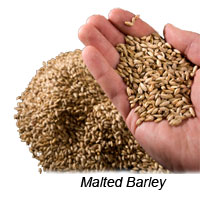 ng routines produce different
degrees of caramelization and toasted flavor in the
malt. A beer can be made from one malt, or from a blend
of malts - this is where the brewmaster's skill and the many
styles of beer begin to emerge. ng routines produce different
degrees of caramelization and toasted flavor in the
malt. A beer can be made from one malt, or from a blend
of malts - this is where the brewmaster's skill and the many
styles of beer begin to emerge.
Making
the Mash - The chosen malts are ground into grist and
mixed with hot water to form a mash.
The barley's enzymes, initially unleashed in the malting
process, are re-inspired by the hot water and continue the
progress of changing the grain's starch to sugar. For the
brewmaster, making the mash is a very sensitive process since
different enzymes are activated at different temperatures.
Extracting
in the Lauter Tun - The heated mash is sieved to
separate the liquid from the leftover grain particulate in a
lauter
tun, a specialized container. The first runoff of
the mash's liquid is very sweet and has the highest
concentration of sugar. The mash may be rinsed with warm water
in a process known as sparging
to gather the remaining sugars. The sugar concentration, also
known as brewing
degrees, is a key measurement for the brewer. The
residual grain husks, (spent
grain), are typically destined for livestock
use.
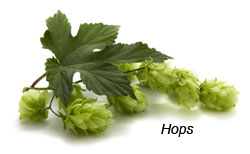 Adding the Hops - Hops are
the flowers of a particular vine, Humulus lupulus. The
flowers have a tiny pinecone-like structure with a yellow
powder, lupulin,
holding the magic. Lupulin provides the bitterness to
beer. As Mr. Oliver explains, "Essentially, it [hops]
acts as a spice. The bitterness of the hop is the backbone of
the beer." The hops' bitterness will provide a
counterpoint to the sweetness of malt in the resulting
beer. Different varieties of hops will lend different
characteristics to various beer styles. Adding the Hops - Hops are
the flowers of a particular vine, Humulus lupulus. The
flowers have a tiny pinecone-like structure with a yellow
powder, lupulin,
holding the magic. Lupulin provides the bitterness to
beer. As Mr. Oliver explains, "Essentially, it [hops]
acts as a spice. The bitterness of the hop is the backbone of
the beer." The hops' bitterness will provide a
counterpoint to the sweetness of malt in the resulting
beer. Different varieties of hops will lend different
characteristics to various beer styles.
Boiling
the Wort - The mixture of sweet liquid from the malted
barley and the added hops is brought to a vigorous boil.
The boiling of this wort
serves at least a couple of purposes - the sterilization of
the liquid and the release of desirable flavors from the
hops.
Fermenting
with Yeast - To the clear wort the brewer adds the
yeast. Two species of yeast are used in beer-making and
this choice will determine whether the beer is an ale or a
lager. Within these two categories are distinct yeast strains
with each lending unique and complex flavors.
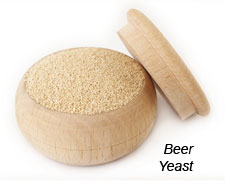 Is it an
Ale? Is it an
Ale? - An ale results when the yeast, Saccharomyces
cerevisae is used. This yeast ferments relatively
quickly and at the higher temperatures of 62 - 75° F.
During fermentation the yeast rises to the top. This
type of brewing is considered to be the older, more
traditional type of brewing. Or is it a
Lager? - A lager is produced when the yeast,
Saccharomyces uvarum is deployed. In contrast to an ale,
this yeast ferments more slowly and at the lower temperatures
of 45 - 56° F.
Mr. Oliver notes,
"Many people seem to think that ales are dark while lagers are
pale, or that ales are strong while lagers are more
moderate. There is no truth to this at all. The
difference is entirely in the yeast, the fermentation
temperature, and the aging time used to produce the
beer."
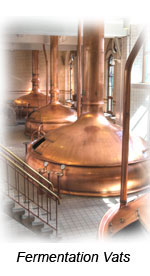 Aging
the Beer - Like wine, aging of the beer brings out
distinctive flavors. Unlike wine, the aging process is
much shorter. Ales age for one month to a year, while
lagers age a month or two in the cold, nearly 32°
F. Aging
the Beer - Like wine, aging of the beer brings out
distinctive flavors. Unlike wine, the aging process is
much shorter. Ales age for one month to a year, while
lagers age a month or two in the cold, nearly 32°
F.
Mr. Oliver eschews "mass-marketed" beers as watered
down, lame versions of what beer should be. He encourages us
to break out and enjoy real beer noting that even real beer is
a very affordable luxury. Try some micro-brews and
support the local economy!
This summary of beer-making
hardly does the subject justice. But, you get some idea
of beer-making complexities and how various brewing choices
might influence the final flavor of beer. We highly
recommend The
Brewmaster's Table by Garrett Oliver as a "must read"
if you're at all curious about beer. It's an exciting
read that is simultaneously entertaining and
informative. We dare you to not be influenced by
Oliver's enthusiasm and expertise!
"Without question, the greatest
invention in the history of mankind is beer. Oh, I grant
you that the wheel was also a fine invention, but the wheel
does not go nearly as well with pizza. - Dave
Barry
|
Cooking with
Beer
|
"Beer has food value, but food has
no beer value." -- Anonymous
Understanding how
beer is made lends great insight to the characteristics it can
lend to food. Beer brings to food the sweetness of its
malt, the bitterness of its hops, and the yeasty grain flavors
of its fermentation. When married with food, the entire
mouth begins to dance.
Bitterness
is Good - Bitterness is often seen as a quality to be
avoided in our food. We have five taste sensations in
our mouth: sweet, sour, salty, bitter, and umami. The
more tastebuds that become excited by food, the richer the
overall flavor experience. Similar to coffee or
chocolate, bitterness is key to our enjoyment even though we
may not be consciously aware of the experience.
Balancing
the Bitterness - After hyping the virtues of
bitterness, we also recognize the need for balance - too much
and it just doesn't taste good. It's the hops in beer
that impart the bitterness. When hops are heated, the
bitterness blooms. By adding beer toward the end of
cooking, the nuanced flavors are added without turning overly
bitter. Consider balancing any bitterness with a little
complementary sweetness - a little molasses in that BBQ sauce,
oven-roasted vegetables in a stew, caramelized onions in a
beer sauce, etc.
Match
the Beer with the Recipe -- Match the type of beer used
with the dish - the stronger the flavors of the recipe, the
stronger, more deeply flavored beer that may be used.
Similarly, a lightly flavored beer fares well in a delicate
batter. Some beer aficionados like to compare ales with
red wines, and lagers with white wines when cooking in the
kitchen. It's not a bad place to start with your
experimentation. Another good rule of thumb is if you
can conceive of the beer as a good beverage to drink with the
dish, then it will probably taste good in
the dish as well.
Use as a
Marinade - Beer has tenderizing properties that make it
an excellent liquid for marinating foods. The
fermentation process produces a panoply of natural chemicals
that act on foods in an enzymatic fashion.
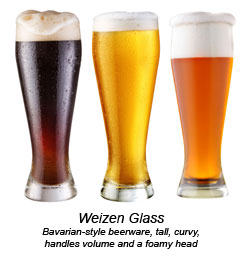 Use as a Leavener - The
yeast and carbonation in beer can also act as a leavener,
albeit a mild one. This quality is what makes beer
batters so great whether in bread (see below), or on onion
rings. Beer batters are noted for their lightness and for the
tender crust and crumb that forms. Use as a Leavener - The
yeast and carbonation in beer can also act as a leavener,
albeit a mild one. This quality is what makes beer
batters so great whether in bread (see below), or on onion
rings. Beer batters are noted for their lightness and for the
tender crust and crumb that forms.
Use as a
Flavor Enhancer - As with wine, alcohol dissolves food
compounds in a way that oil or water cannot accomplish. The
alcohol in beer uncovers aromas and tastes that would
otherwise be held hostage in the foods' chemical bonds.
"Beer: Because
one doesn't solve the world's problems over white wine." -
Anonymous
|
Drinking
Beer Well
|
"Beer is proof that God loves us
and wants us to be happy." - Benjamin
Franklin
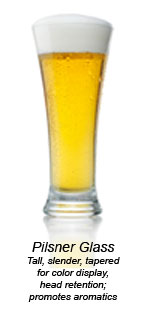 Most recipes call for one bottle of beer
leaving us with the dilemma of what to do with the other five
in the pack. We recommend drinking any leftovers while
your recipe cooks and at the table for full dining
enjoyment! Most recipes call for one bottle of beer
leaving us with the dilemma of what to do with the other five
in the pack. We recommend drinking any leftovers while
your recipe cooks and at the table for full dining
enjoyment!
As with wine, the pleasure begins with the
beer's aromas. Chemists have identified over a thousand
compounds involved in the aroma of beer. Imagine a
thousand stimuli sweetly bombarding your nose at once.
Pairing
Beer with Food - Beer aficionados purport that beer is
much more versatile than wine at the table. They assert
that there is a beer to match every food, while wine struggles
to match many foods, especially spicy, ethnic cuisines.
In fact, Mr. Oliver in The
Brewmaster's Table reports high-brow taste tests of
beer-and-cheese vs. wine-and-cheese. The beer pairings
won! He claims that it is the broad spectrum of beer
styles and the common origins of fermented and aged grain
shared by both foods that make beer-and-cheese the better
partners.
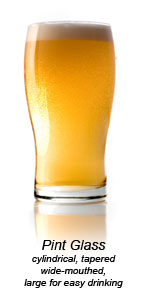 So which beer goes with which food?
Start by matching food qualities with similar beer qualities -
bitter with bitter, strong with strong, herbal with herbal,
acidity with acidity, sweet to sweet, etc. Similar to
wine, begin a meal with lighter, delicate brews proceeding to
stronger, drier flavors, and finishing with sweeter
beers. Enjoy the process of experimentation, and at the
end of the day, follow what tastes good to you! So which beer goes with which food?
Start by matching food qualities with similar beer qualities -
bitter with bitter, strong with strong, herbal with herbal,
acidity with acidity, sweet to sweet, etc. Similar to
wine, begin a meal with lighter, delicate brews proceeding to
stronger, drier flavors, and finishing with sweeter
beers. Enjoy the process of experimentation, and at the
end of the day, follow what tastes good to you!
Serve
Beer in the Right Glass - The taste and pleasure of
beer is greatly impacted by how it's served. Serve beer
in a clear glass that shows off the beautiful amber color and
the foamy head. Choose a style of glass that will
present those thousand aromatic components in the best
fashion. Breweries often design a glass alongside with
designing a new beer. Different glass shapes, along with
the pour, will present the beer differently to the nose and to
the mouth. The slightly irreverent, but highly
knowledgeable website, www.beeradvocate.com, has an exhaustive
glossary of beers and the proper glassware suited to each
beer.
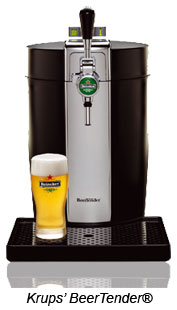 Serve Beer at the Right
Temperature - Beer is refreshing in a way that
sipping wine can never be. The cold and carbonation of
beer combine for thirst-quenching exhilaration. The taste of
beer will change based on the temperature at which it's
served. Colder beer will taste dryer and bitterer;
warmer beer will be more aromatic, flavorful, and
sweeter. Home refrigerators hum along at 39-40° F which
may be too cold for most beers. Pale lagers prefer
chilling at 45° F, wheat beers at 47° F, dark lagers at 48° F,
ales, stouts, lambics, and bitters at 55° F, and strong dark
ales, porters, and stouts at 60° F. Serve Beer at the Right
Temperature - Beer is refreshing in a way that
sipping wine can never be. The cold and carbonation of
beer combine for thirst-quenching exhilaration. The taste of
beer will change based on the temperature at which it's
served. Colder beer will taste dryer and bitterer;
warmer beer will be more aromatic, flavorful, and
sweeter. Home refrigerators hum along at 39-40° F which
may be too cold for most beers. Pale lagers prefer
chilling at 45° F, wheat beers at 47° F, dark lagers at 48° F,
ales, stouts, lambics, and bitters at 55° F, and strong dark
ales, porters, and stouts at 60° F.
The
Perfect Pour of Liquid Gold - The Krups Company and
Heineken beer have collaborated to make true draught beer
available at home. The BeerTender®
holds a small keg (10 pints) of beer at the perfect
temperature and with the perfect carbonation level. The
small kegs, once tapped, will remain fresh for 30 days. The
sleek, elegant design of the BeerTender®
takes "beer-on-tap" at home to a whole new
level.
|
Cucina Fresca's Smart Beer
Tips
|
Tip #1: If you're
inspired to explore beer a little more, host a
beer-tasting. Begin with lighter flavored beers and
proceed to strongly flavored beers. 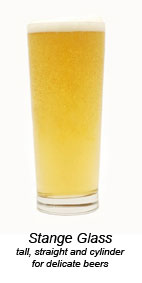 Thanks to Jimmy Carter, who
repealed home-brewing prohibitions, you can also join the
resurgence of home-brewing. You don't need a vineyard or a
Mediterranean climate in order to give it a go. Thanks to Jimmy Carter, who
repealed home-brewing prohibitions, you can also join the
resurgence of home-brewing. You don't need a vineyard or a
Mediterranean climate in order to give it a go.
Tip #2: Avoid using
frosted beer glasses or mugs for serving beer. The
ultra-cold glass changes the temperature of the beer,
depresses volatile aromatics, dilutes it, and may capture
freezer odors that get passed on to the beer. Focus on
chilling the beer to the right temperature and enjoying it in
a reasonable amount of time, i.e., before it gets too
warm.
Tip
#3: Try a unique dessert of a vanilla ice cream
float made with a Chocolate Stout.
Tip #4: Store beer in
cool, dry, dark places. Harold McGee, NY Times' "Curious
Cook," 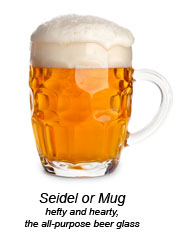 explains that the ultraviolet
component of light causes the breakdown of riboflavin in both
beer and milk. This break up yields compounds that
result in an undesirable "skunkiness." explains that the ultraviolet
component of light causes the breakdown of riboflavin in both
beer and milk. This break up yields compounds that
result in an undesirable "skunkiness."
Tip: #5: Drinking beer
from a bottle denies one the pleasure of the beer's aroma and
foamy head. Pour beer properly by sliding two-thirds to
three-quarters of the beer down the side of a tilted
glass. Finish the pour with an upright glass and a pour
to the center so that a foamy head "two fingers tall" is
formed.
Tip
#6: Of course, equip your guests with coasters
when you serve beer. In many parts of Europe, the
coaster on top of your beer glass is a signal that you're done
and that the server should cease the automatic
refills.
|
Q &
A's
|
 Q: What is non-alcoholic
beer, and is it better to cook with? Q: What is non-alcoholic
beer, and is it better to cook with?
A: Non-alcoholic
beer, (fake beer, near beer, NA beer) has less than 0.5%
alcohol content. It may be used in cooking, but the
flavors released by exposure to alcohol will be missing.
In general, the flavor will be lighter though still worthy and
pleasurable.
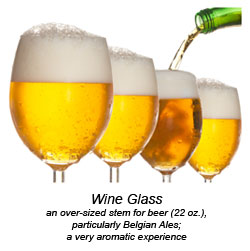 Q: What are
IBU's? Q: What are
IBU's?
A: Similar to the
Scoville scale that measures the heat of chile peppers, the
International Bittering Units scale is a universal measuring
system used for quantifying the bitterness of beer.
Sometimes a beer bottle will note the number of IBU's on its
label. A beer with more than 40 IBU's is considered to
be fairly bitter.
Q: Why is a lime served with
some Mexican beers?
A: Opinions on this
tradition range from "it's to mask bad beer," to "it's to
remove the rust ring from the bottle's mouth (before rubber
rings were part of the cap)," to "it keeps the flies
away," to "it's reminiscent of a Michelada, a beer cocktail
made with lime juice and hot sauce."
Q: When cooking with beer, how
quickly does the alcohol burn off?
A: It depends on the
amount of beer used, the volume of the entire recipe and the
cooking temperature. Beer has less alcohol per volume
than wine, but in cooking (or drinking) a greater volume is
used such that the amount of alcohol is similar. The
longer the recipe is heated, the more alcohol that
evaporates. Higher heat will speed the dissipation, but
will also inspire the hops' bitterness.
Q: When did beer start to come
in cans instead of bottles?
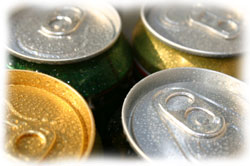 A: Beer in a can
generally goes with mass-marketed beers, while beer in bottles
is characteristic of smaller breweries. The beer can
came on the scene after the end of Prohibition in the
mid-1930's as a way to eliminate weight and shipping expense,
and to achieve greater manufacturing ease compared to
recycling bottles. Older, flat-top beer cans required piercing
with tool (a "church key"), the "pull-tab" was introduced in
1963, and the attached, "stay tab" (less litter) made its
appearance in 1975. Beer can collecting is a whole other
topic. . . . A: Beer in a can
generally goes with mass-marketed beers, while beer in bottles
is characteristic of smaller breweries. The beer can
came on the scene after the end of Prohibition in the
mid-1930's as a way to eliminate weight and shipping expense,
and to achieve greater manufacturing ease compared to
recycling bottles. Older, flat-top beer cans required piercing
with tool (a "church key"), the "pull-tab" was introduced in
1963, and the attached, "stay tab" (less litter) made its
appearance in 1975. Beer can collecting is a whole other
topic. . . .
|
Cookbook
Review
|
The
Ultimate Beer Lover's Cookbook by John Schlimm.
Published by Cumberland House Publishing, Inc., Copyright
2008. Distributed by Sourcebooks, Inc.
The unifying
theme of this cookbook is, of course, beer -- beer in
breakfast foods, lunch, dinner and snacks. As decadent
as this sounds, we know that most alcohol disappears in
cooking, leaving behind wonderful complexities of flavor to be
enjoyed thoroughly any time of day. The author, John
Schlimm, is clearly passionate about his subject and 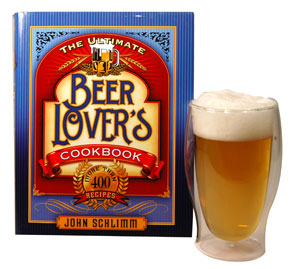 enthusiastically shares his
obsession in the introduction and throughout the book.
He brings a wealth of knowledge to the subject along with a
sense of humor and a healthy respect for beer folklore.
This hefty book of more than 400 recipes is organized in
twenty-seven chapters ranging from Appetizers to Soups &
Chili, Salads, Steak, Wild Game, Cakes, Cookies, etc., and
seven different beverage chapters. Tried and true
favorites are immortalized as well as many innovative twists
on some pretty unique dishes. The book is spiced with famous
quotations that will amuse and entertain. We're pretty
sure you know someone who would enjoy cooking from this book
or better yet, having you cook from this
book! enthusiastically shares his
obsession in the introduction and throughout the book.
He brings a wealth of knowledge to the subject along with a
sense of humor and a healthy respect for beer folklore.
This hefty book of more than 400 recipes is organized in
twenty-seven chapters ranging from Appetizers to Soups &
Chili, Salads, Steak, Wild Game, Cakes, Cookies, etc., and
seven different beverage chapters. Tried and true
favorites are immortalized as well as many innovative twists
on some pretty unique dishes. The book is spiced with famous
quotations that will amuse and entertain. We're pretty
sure you know someone who would enjoy cooking from this book
or better yet, having you cook from this
book!
|
Recipes with
Beer
|
Recipes excerpted from The
Ultimate Beer Lover's Cookbook by John Schlimm.
Published by Cumberland House Publishing, Inc. Copyright
2008. Reprinted with permission of Sourcebooks, Inc. All
rights reserved.
Light
Beer Bread
 This bread went together so quickly, we
had to check the recipe to make sure we had covered all of the
steps. The result was a lovely, moist, warm loaf that
proved a worthy canvas for some Irish butter that was on
hand. The bread had a yeast bread quality, but clearly
falls into the quick bread category. Hefty and hearty,
this bread was a perfect accompaniment to our soup. Mix
an extra set of dry ingredients for an even quicker loaf of
fresh bread the next time - just add a beer, stir and
bake! This bread went together so quickly, we
had to check the recipe to make sure we had covered all of the
steps. The result was a lovely, moist, warm loaf that
proved a worthy canvas for some Irish butter that was on
hand. The bread had a yeast bread quality, but clearly
falls into the quick bread category. Hefty and hearty,
this bread was a perfect accompaniment to our soup. Mix
an extra set of dry ingredients for an even quicker loaf of
fresh bread the next time - just add a beer, stir and
bake!
Click here to view the
recipe.
Click here for a
printable version
of the recipe.
Potato
& Cabbage Casserole
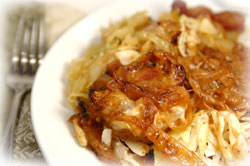 This casserole is a perfect homage to
these two winter vegetables. Strategically layered, the
potatoes and cabbage form the basic structure for the dish;
the cheese, onions, and beer sauce meld the layers
together. In our opinion, the onion and beer sauce is
worth recreating for any number of applications - it's
delicious and imparts a rich taste to the entire dish.
We matched our helpings with a fresh lager that proved to be
refreshing and clear. We were planning on the leftovers for
the next day, but there weren't any! This casserole is a perfect homage to
these two winter vegetables. Strategically layered, the
potatoes and cabbage form the basic structure for the dish;
the cheese, onions, and beer sauce meld the layers
together. In our opinion, the onion and beer sauce is
worth recreating for any number of applications - it's
delicious and imparts a rich taste to the entire dish.
We matched our helpings with a fresh lager that proved to be
refreshing and clear. We were planning on the leftovers for
the next day, but there weren't any!
Click here to view the
recipe.
Click here for a
printable version
of the recipe.
Reuben
Soup
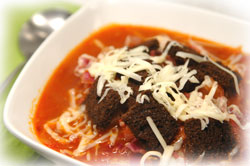 We thought this soup sounded a bit
gimmicky at first, but it turns out that it's a gimmick that
works beautifully and deliciously! All of the signature
ingredients of a great Reuben sandwich are present in this
soup - corned beef, sauerkraut, mustard, pumpernickel and
Swiss cheese. The combination of sauerkraut and fresh
cabbage makes this a hearty soup. The beer in the soup
was subtly present, but the beer that we drank with this soup,
a dark ale, fit the occasion perfectly - the sturdiness of one
matching the other. Don't skimp on the pumpernickel
croutons and the Swiss cheese - they complete the flavor
confab perfectly! We thought this soup sounded a bit
gimmicky at first, but it turns out that it's a gimmick that
works beautifully and deliciously! All of the signature
ingredients of a great Reuben sandwich are present in this
soup - corned beef, sauerkraut, mustard, pumpernickel and
Swiss cheese. The combination of sauerkraut and fresh
cabbage makes this a hearty soup. The beer in the soup
was subtly present, but the beer that we drank with this soup,
a dark ale, fit the occasion perfectly - the sturdiness of one
matching the other. Don't skimp on the pumpernickel
croutons and the Swiss cheese - they complete the flavor
confab perfectly!
Click here to view the
recipe.
.
Click here for a
printable version
of the
recipe.
|
Bridal
Registry
|
Wedding
season in quickly approaching. Join us in celebrating the
engagements and pending nuptials for the following couples
registered at Cucina Fresca in 2009:

Ruth
Meyer and Tim Feldman
Wedding Date: June 27th
2009
Korrie Vance
and Shaun Hornbarger
Wedding Date: July
18th 2009
Holly
Gilbertson and Brett Hoffman
Wedding Date: August
15th 2009
Wedding Registry List is available on our
website | |
Franklin
D. Roosevelt, upon signing the repeal of Prohibition, was
reported to say, "I think
this would be a good time for a beer."
We
agree! |
|
| |